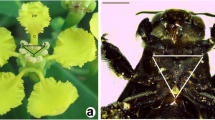Abstract
Two stigma forms occur inChamaecrista andSenna, but only one inCassia. In the common chambered form, a stigma pore is positioned on the reflexed style tip and is the entrance to a tapering chamber. The pore rim is fringed by hairs which vary in number, size, distribution and shape. In the alternative form the stigma is situated at the apex of the curved style and is crateriform. The crater rim is fringed by hairs of variable number and shape. The stigmatic hairs are predominantly unicellular and cutinized. Stigma and hair differences aid in the taxonomy of the genera. Their functions in pollination biology are discussed.
Similar content being viewed by others
References
Burck, W., 1887: Notes biologique, 2. Dispositions des organes dans les fleurs dans le but de favoriser l'auto-fecondation. — Ann. Jard. Bot. Buitenzorg, Batavia6: 251–267.
Delgado, S. A., Sousa, S. M, 1977: Biologia floral del generoCassia en la region de los Tuxtlas, Veracrux. — Bol. Soc. Bot. Mexico37: 5–52.
Dulberger, R., 1981: The floral biology ofCassia didymobotrya andC. auriculata (Caesalpiniaceae). — Amer. J. Bot.68: 1350–1360.
Gale, R. M. O., Owens, S. J., 1983: The occurrence of an epicuticular layer on the abaxial surface of petals ofTradescantia sp. (Commelinaceae). — Kew Bull.37: 515–519.
Graham, A., Barker, G., 1981: Palynology and tribal classification in theCaesalpinioideae. — InPolhill, R. M., Raven, P. H., (Eds.): Advances in legume systematics, pp. 801–834. — Kew: Royal Botanic Gardens.
Heslop-Harrison, Y., 1981: Stigma characteristics and angiosperm taxonomy. — Nordic J. Bot.1: 401–420.
—, 1977: The receptive surface of the angiosperm stigma. — Ann. Bot.41: 1233–1258.
Irwin, H. S., Barneby, R. C., 1981: Tribe 2.Cassieae Bronn (1822). — InPolhill, R. M., Raven, P. H., (Eds.): Advances in legume systematics, pp. 97–106. — Kew: Royal Botanic Gardens.
- - 1982: The AmericanCassiinae. A synoptical revision ofLeguminosae tribeCassieae subtribeCassiinae in the New World. — Mem. New York Bot. Gard.35, parts 1 & 2, 918 pp.
Lewis, G. P., 1984: Review ofIrwin, H. S., Barneby, R. C., 1982. The AmericanCassiinae. A synoptical revision ofLeguminosae tribeCassieae subtribeCassiinae in the New World. — Kew Bull.39: 664–666.
Owens, S. J., 1985: Stigma structure and the pollen-stigma interaction inCaesalpinioideae. — InWillemse, M. T. M., Van Went, J. L., (compilers): Sexual reproduction in seed plants, ferns and mosses, pp. 84–87. — Proceedings of the 8th International symposium on sexual reproduction in seed plants, ferns and mosses, 20–24th August 1984. — Wageningen, the Netherlands: Pudoc.
Robertson, C., 1890: Flowers and insects, 5. — Bot. Gaz.15: 199–204.
Author information
Authors and Affiliations
Rights and permissions
About this article
Cite this article
Owens, S.J., Lewis, G.P. Taxonomic and functional implications of stigma morphology in species ofCassia, Chamaecrista, andSenna (Leguminosae:Caesalpinioideae). Pl Syst Evol 163, 93–105 (1989). https://doi.org/10.1007/BF00936157
Issue Date:
DOI: https://doi.org/10.1007/BF00936157




